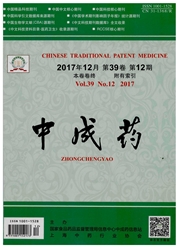

 中文摘要:
中文摘要:
目的:研究当归不同炮制品清除自由基的药效物质基础。方法:采用Fenton反应产生羟自由基和邻苯三酚自氧化产生氧自由基模型,研究当归炮制品酒当归、油当归、土当归和当归碳体外清除自由基的作用,HPLC法建立其指纹图谱,鉴定了11个共有峰,多元线性回归法分析当归不同炮制品中化学成分与清除自由基之间的关系。结果:不同浓度当归炮制品醇提液对羟自由基和氧自由基都有一定的清除作用,随浓度的增大,清除率显著增高,呈现良好的剂量依赖关系;回归分析结果表明,峰10所代表的化合物Z-丁烯基酞内酯和峰4所代表的未知化合物与羟自由基和氧自由基的清除密切相关,其中化合物Z-丁烯基酞内酯与抗自由基呈正相关关系,峰4所代表的未知化合物与抗自由基呈负相关关系;阿魏酸、丁基酜内酯与清除羟自由基呈正相关关系,洋川芎内酯H和levistolide A.与清除氧自由基密切相关。结论:Z-丁烯基酞内酯、阿魏酸、丁基酜内酯、洋川芎内酯H、levistolide A.和峰4代表的未知化合物是当归炮制品清除自由基的药效物质基础。
 英文摘要:
英文摘要:
AIM: To study the effect of chemical compound of processed angelica on scavenging free radicals.METHODS: The free radicals’models induced by Fenton reaction and the antioxidation of pyrogallol,which could generate hydroxyl radical and superoxide radical,respectively,were applied to the raw angelica,angelica stir-fried with edible oil,stir-fried with yellow rice wine,stir-fried with earth and carbonized angelica,fingerprint chromatograms of processed products were developed by HPLC.Eleven common peaks of HPLC fingerprints were found by assigning ferulic acid peak as the reference peak,the multiple linear regression analytical method was ap-plied to the relationship between the chromatographic fingerprints and scavenging free radical.RESULTS: The al-coholic extracts from angelica processed products had scavenging actions on hydroxyl radical as well as superoxide radical,scavenging rate increased with the increase of concentration,and showed good dose-effective relationship;The results of regression analysis indicated that Z-butylidenephthalide and unknown compound represented by peak 10 and 4 respectively were correlated with scavenging hydroxyl and superoxide radical,Z-butylidenephthalide showed a positive correlation but unknown compound showed a negative correlation.Ferulic acid and senkyunolide A were positively correlated with scavenging hydroxyl radical,but senkyunolide H and levistolide A.were correlated with scavenging superoxide radical.CONCLUSION: Z-butylidenephthalide,Z-butylidenephthalide,ferulic acid,senkyunolide A,senkyunolide H,levistolide A.and unknown compound represented by peak 4 were the main effec-tive constituents scavenging free radicals.
 同期刊论文项目
同期刊论文项目
 同项目期刊论文
同项目期刊论文
 期刊信息
期刊信息
